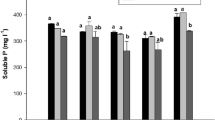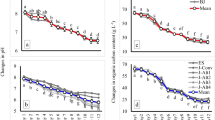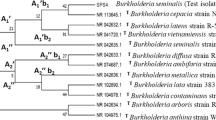Abstract
The current study was undertaken to determine the ability of different carrier materials for sustaining the viability of microbial consortium during storage. Different bioformulations consisting of carrier material and microbial consortium were prepared and examined for viability and stability for one year stored at 4 °C and ambient temperature. Total 8 bio-formulations were prepared consisting five economically viable carriers (gluten, talc, charcoal, bentonite, broth medium) and a microbial consortium. In present study, maximum enhanced shelf-life of consortium based on colony forming unit count were recorded for talc + gluten based (B4) bioformulation (9.03 log10 cfu/g) over other bio-formulations stored for 360 days. Furthermore, the pot experiments was conducted to evaluate the efficacy of B4 formulation on growth of spinach in comparison with recommended dose of chemical fertilizer, uninoculated and no amendment control. The results depicted that B4 formulation increased biomass (176–666%), leaf area (33–123%), chlorophyll content (131–789%) and protein content (68.4–94.4%) of spinach over controls. Further B4 application significantly increased the nutrients like available nitrogen (131–475%), phosphorus (75–178%) and potassium (31–191%) of pot soil along with noteworthy improvement in root colonization as evident from scanning electron microscope analysis in comparison to controls at 60 days after sowing. Therefore, exploiting B4 formulation can serve as the environmentally sound approach to enhance the productivity, biomass and nutritional value of spinach. Thus, Plant growth promoting microbes-based formulation can be the novel paradigm to improve the soil health and eventually the crop productivity in economical and sustainable manner.






Similar content being viewed by others
References
Abd El Fattah DA, Eweda WE, Zayed MS, Hassanein MK (2013) Effect of carrier materials, sterilization method, and storage temperature on survival and biological activities of Azotobacter chroococcum inoculant. Annual Agri Sci 58(2):111–118
Aloo BN, Mbega ER, Makumba BA, Tumuhairwe JB (2022) Effects of carrier materials and storage temperatures on the viability and stability of three biofertilizer inoculants obtained from potato (Solanum tuberosum L.) rhizosphere. Agriculture 12:140
Amalraj ELD, Mohanty D, Kumar GP, Desai S, Ahmed SKMH, Pradhan R, Khan SS (2015) Potential microbial consortium for plant growth promotion of sunflower (Helianthus annuus L.). Proc Natl Acad Sci 85(2):635–642
Asif M, Pervez A, Irshad U, Mehmood Q, Ahmad R (2020) Melatonin and plant growth-promoting rhizobacteria alleviate the cadmium and arsenic stresses and increase the growth of Spinacia oleracea L. Plant Soil Environ 66(5):234–241
Awasthi A (2019) Field-specific microbial consortium are feasible: a response to Kaminsky et al. Trends Biotechnol 37(6):569–572
Babalola OO (2010) Beneficial bacteria of agricultural importance. Biotech Lett 32(11):1559–1570
Bakhsh K, Akram W, Jahanzeb A, Khan M (2016) Estimating productivity of Bt cotton and its impact on pesticide use in Punjab. Pakistan Pak Econ Soc Rev 54(1):15–24
Bashan Y, de-Bashan LE, Prabhu S, Hernandez JP (2014) Advances in plant growth-promoting bacterial inoculant technology: formulations and practical perspectives (1998–2013). Plant Soil 378:1–33. https://doi.org/10.1007/s11104-013-1956-x
Brahmaprakash G, Sahu PK (2012) Biofertilizers for sustainability. J Ind Inst Sci 92:37–62
Brockwell J, Bottomley PJ (1995) Recent advances in inoculant technology and prospects for the future. Soil Biol Biochem 27:683–687
Cho CF, Lee WC (1999) Formulation of a biocontrol agent by entrapping biomass of Trichoderma viride in Gluten matrix. J Biosci Bioeng 87(6):822–824
Elkoca E, Turan M, Donmez MF (2010) Effects of single, dual and triple inoculations with Bacillus subtilis, Bacillus megaterium and Rhizobium leguminosarum by Phaseoli on nodulation, nutrient uptake, yield and yield parameters of common bean (Phaseolus vulgaris L. cv. ‘Elkoca-05’). J Plant Nutr 33:2104–2119
Fravel DR, Marois JJ, Lumsden RD, Connick WJJ (1985) Encapsulation of potential biocontrol agents in an alginate-clay matrix. Phytopathology 75:774–777
Gomez AJ, Felix JDF, Fraile PG, Mateos PF, Menendez E, Velazquez E, Rivas R (2018) Probiotic activities of Rhizobium laguerreae on growth and quality of spinach. Sci Rep 8:295. https://doi.org/10.1038/s41598-017-18632
Gunjal A, Kapadnis B, Pawar N (2012) Agroindustry by-products as a carrier resource for plant-growth-promoting rhizobacterium, Bacillus subtilis. J Mater Cycles Waste Manag 14:274–280
Gupta, Vandana (2019) Effect of PGPR isolates on plant growth promotion in relation to salinity stress. Bull Environ Pharmacol Life Sci 8(12):18–26.
Inostroza NG, Barra PJ, Wick LY, Mora ML, Jorquera MA (2016) Effect of rhizobacterial consortia from undisturbed arid- and agroecosystems on wheat growth under differing conditions. Lett Appl Microbiol 64:158–163
Jackson MI (1973) Soil and chemical analysis prentice hall of India private limited, New Delhi.
James D, Mathew SK (2017) Compatibility studies on different endophytic microbes of tomato antagonistic to bacterial wilt pathogen. IJABR 7(1):190–194
Kapadia C, Sayyed RZ, El Enshasy HA, Vaidya H, Sharma D, Patel N, et al (2021) Halotolerant microbial consortia for sustainable mitigation of salinity stress, growth promotion, and mineral uptake in tomato plants and soil nutrient enrichment. Sustainability 13(15):8369
Khan MY, Zahir AZ, Asghar HN, Waraich EA (2017) Preliminary investigations on selection of synergistic halotolerant plant growth promoting rhizobacteria for inducing salinity tolerance in wheat. Pak J Bot 49(4):1541–1551
Khandare RN, Chandra R, Pareek N, Raverkar KP (2019) Carrier-based and liquid bioinoculants of Azotobacter and PSB saved chemical fertilizers in wheat (Triticum aestivum L.) and enhanced soil biological properties in Molli sols. J Plant Nutr 1–15.
Kour D, Rana K, Kaur T, Yadav N, Yadav AN, Rastegari AA, Saxena AK (2020) Microbial biofilms: functional annotation and potential applications in agriculture and allied sectors. In: Yadav MK, Singh BP (eds) New and future developments in microbial biotechnology and bioengineering: microbial biofilms. Elsevier, Cambridge, pp 283–301
Kumar S, Thakur M, Rani A (2014) Trichoderma: mass production, formulation, quality control, delivery and its scope in commercialization in India for the management of plant diseases. Afr J Agric Res 9(53):3838–3852. https://doi.org/10.5897/AJAR2014.9061
Kushwaha CP, Tripathi SK, Singh KP (2001) Soil organic matter and water-stable aggregates under different tillage and residue conditions in a tropical dryland agroecosystem. Appl Soil Ecol 16:229–241
Ma Y (2019) Seed coating with beneficial microorganisms for precision agriculture. Biotechnol Adv 107423.
Maddhesiya PK, Singh K, Singh RP (2021) Effect of perennial aromatic grass species richness and microbial consortium on soil properties of marginal lands and biomass production. Land Degrad Dev 32(2):1008–1021
Maheshwari DK, Dubey RC, Agarwal M, Dheeman S, Aeron A, Bajpai VK (2015) Carrier based formulations of biocoenotic consortia of disease suppressive Pseudomonas aeruginosa KRP1 and Bacillus licheniformis KRB1. Ecol Eng 81:272–277
Mastan A, Rane D, Dastager SG, Babu CSV (2019) Development of low-cost plant probiotic formulations of functional endophytes for sustainable cultivation of Coleus forskohlii; Microbiol Res 227:126310. https://doi.org/10.1016/j.micres.2019.126310
Mishra R, Singh RP (2022) Effect of species diversity levels and microbial consortium on biomass production, net economic gain, and fertility of marginal land. Land Degrad Dev 1–12. https://doi.org/10.1002/ldr.4195
Mishra R, Dubey P and Singh RP (2021) Assessing the efficacy of climate resilient microbial inoculants for enhanced phytochemical production from Indian licorice (Abrus precatorius L.). Medicinal Plants 13(2):330–338.
Monica S, Karthik L, Mythili S, Sathiavelu A (2011) Formulation of effective microbial consortia and its application for sewage treatment. J Microbial Biochem Technol 3:051–055
Park JK, Chang HN (2000) Microencapsulation of microbial cells. Biotechnol Adv 18:303–319
Parveen N, Singh DV, Singh RP (2022a) Developing an effective microbial community as bioinoculant for enhanced productivity of tomato (Lycopersicon esculantum Mill.) with improved soil fertility. IJFANS 11(3):2419–2430.
Parveen N, Mishra R, Singh RP (2022b) Assessing the efficacy of microbial bioformulations in enhancing biomass and defence related compounds of spinach (Spinacia Oleracea L.). IJFANS 11(3):3482–3497.
Petrillo C, Vitale E, Ambrosino P, Arena C, Isticato R (2022) Plant growth promoting bacterial consortia as a strategy to alleviate drought stress in Spinacia oleracea. Microorganism 10:1798.
Rastegari AA, Yadav AN, Yadav N (2020) Trends of microbial biotechnology for sustainable agriculture and biomedicine systems: diversity and functional perspectives. Elsevier, Amsterdam
Roy BD, Deb B, Sharma GD (2010) Evaluation of carrier-based inoculants of Azotobacter Chroococcun strain SDSA-112/2 in improving growth and yield of summer rice. IR-36. Biofrent 1:36–40
Sachdev S, Singh RP (2018) Isolation, characterisation and screening of native Aguirre environ. Sustan 6(1):46–58
Schoebitz M, Vidal G (2016) Microbial consortium and pig slurry to improve chemical properties of degraded soil and nutrient plant uptake (Schoebitz and Vidal, 2016). J Soil Sci Plant Nutr 16(1):226–236
Sethi SK, Adhikary SP (2012) Cost effective pilot scale production of biofertilizer using Rhizobium and Azotobacter. Afr J Biotechnol 11:13490–13493
Seymen M (2021) How does the flooding stress occurring in different harvest times affect the morpho-physiological and biochemical characteristics of spinach? Sci Hortic 275:109713
Shahzad S, Khan MY, Zahir AZ, Asghar HN, Chaudhry UK (2017) Comparative effectiveness of different carriers to improve the efficacy of bacterial consortium for enhancing wheat production under salt affected field conditions. Pak J Bot 49(4):1523–1530
Shilev ST, Babrikova I, Babrikov T (2019) Consortium of plant growth-promoting bacteria improves spinach (Spinacea oleracea L.) growth under heavy metal stress conditions. J Chem Technol Biotechnol. https://doi.org/10.1002/jctb.6077
Shilpa ME and Brahmaprakash GP (2016) Amendment of carrier with organic material for enhancing shelf life of microbial consortium. J Pure Appl Microbiol 10(4):2835–2842. https://doi.org/10.22207/JPAM.10.4.44
Singh J, Singh AV, Upadhayay VK, Amir K (2020) Comparative evaluation of developed carrier based bioformulations bearing multifarious PGP properties and their effect on shelf life under different storage conditions. Environ Ecol 38(1):96–103
Sivakumar PK, Parthasarthi R, Lakshmipriya VP (2014) Encapsulation of plant growth-promoting inoculant in bacterial alginate beads enriched with humid acid. Int J Curr Microbiol Appl Sci 3:415–422
Sohaib M, Zahir AZ, Khan MY, Ans M, Asghar HNSY, Al-Barakah FNI (2020) Comparative evaluation of different carrier-based multi-strain bacterial formulations to mitigate the salt stress in wheat. Saudi J Biol Sci 27:777–787. https://doi.org/10.1016/j.sjbs.2019.12.034
Solanki HK, Shah DA (2016) Formulation optimization and evaluation of probiotic Lactobacillus sporogenes-loaded sodium alginate with carboxymethyl cellulose mucoadhesive beads using design expert software. J Food Proc 1–1:4
Szopa D, Mielczarek M, Skrzypczak D, Izydorczyk G, Katarzyna M, Katarzyna C, Krowiak AW (2022) Encapsulation efficiency and survival of plant growth-promoting microorganisms in an aginate- based natrix—a systematic review and protocol for a practical approach. Ind Crops Prod 181:114846
Tamreihao K, Ningthoujam DS, Nimaichand S, Singh ES, Reena P, Singh SH, Nongthomb U (2016) Biocontrol and plant growth promoting activities of a Streptomyces corchorusii strain UCR3-16 and preparation of powder formulation for application as biofertilizer agents for rice plant. Microbiol Res 192:260–270. https://doi.org/10.1016/j.micres.2016.08.005
Tripathi S, Chandra ADA, Varma A (2015) Development of carrier-based formulation of root endophyte Piriformospora indica and its evaluation on Phaseolus vulgaris L. World J Microbiol Biotechnol 31:337–344
Tripti KA, Usmani Z, Kumar V, Anshumali (2017) Biochar and flyash inoculated with plant growth promoting rhizobacteria act as biofertilizer for luxuriant growth and yield of tomato plant. J Environ Manag 190:20–27. https://doi.org/10.1016/j.jenvman.2016.11.060
Upadhyay SK, Singh JS, Saxena AK, Singh DP (2012) Impact of PGPR inoculation on growth and antioxidant status of wheat under saline conditions. Plant Biol 14:605–611
Varma A, Schuepp H (1994) Positive influence of arbuscular mycorrhizal fungus on in vitro raised hortensia plantlets. Angew Bot 68:108–113
Vassilev N, Vassileva M, Lopez A, Martos V, Reyes A, Maksimovic I, Eichler LB, Malusa E (2015) Unexploited potential of some biotechnological techniques for biofertilizer production and formulation. Appl Microbiol Biotechnol 99:4983–4996
Vitale L, Vitale E, Guercia G, Turano M, Arena C (2020) Effects of different light quality and biofertilizers on structural and physiological traits of spinach plants. Photosynthetica 58(4):932–943. https://doi.org/10.32615/ps.2020.039
Xu J, Jiang Z, Li M, Li Q (2019) A compost-derived thermophilic microbial consortium enhances the humification process and alters the microbial diversity during composting. J Environ Manag 243:240–249
Zahir ZA, Ahmad M, Hilger TH, Dar A, Malik SR, Abbas G, Rasche F (2018) Field evaluation of multistrain biofertilizer for improving the productivity of different mungbean genotypes. Soil Environ 37:45–52
Acknowledgements
Authors are thankful to the university for providing lab facility. NP is grateful to the ministry of tribal affairs for providing financial assistance as NFST—JRF [Ref No—201920-NFST-JAM-02504).
Funding
Funding was provided by Ministry of Tribal Affairs, Govt of India (Ref No—201920-NFST-JAM-02504).
Author information
Authors and Affiliations
Contributions
RPS conceptualized the idea. NP performed the experiments. NP wrote the manuscript, NP, RM, DVS, PK and RPS reviewed the manuscript.
Corresponding author
Ethics declarations
Conflict of interest
The authors report no declarations of interest.
Ethical approval
This article does not contain any studies with human or animal subjects.
Additional information
Publisher's Note
Springer Nature remains neutral with regard to jurisdictional claims in published maps and institutional affiliations.
Supplementary Information
Below is the link to the electronic supplementary material.
Rights and permissions
Springer Nature or its licensor (e.g. a society or other partner) holds exclusive rights to this article under a publishing agreement with the author(s) or other rightsholder(s); author self-archiving of the accepted manuscript version of this article is solely governed by the terms of such publishing agreement and applicable law.
About this article
Cite this article
Parveen, N., Mishra, R., Singh, D.V. et al. Assessment of different carrier materials for the preparation of microbial formulations to enhance the shelf life and its efficacy on the growth of spinach (Spinacia oleracea L.). World J Microbiol Biotechnol 39, 180 (2023). https://doi.org/10.1007/s11274-023-03594-4
Received:
Accepted:
Published:
DOI: https://doi.org/10.1007/s11274-023-03594-4




